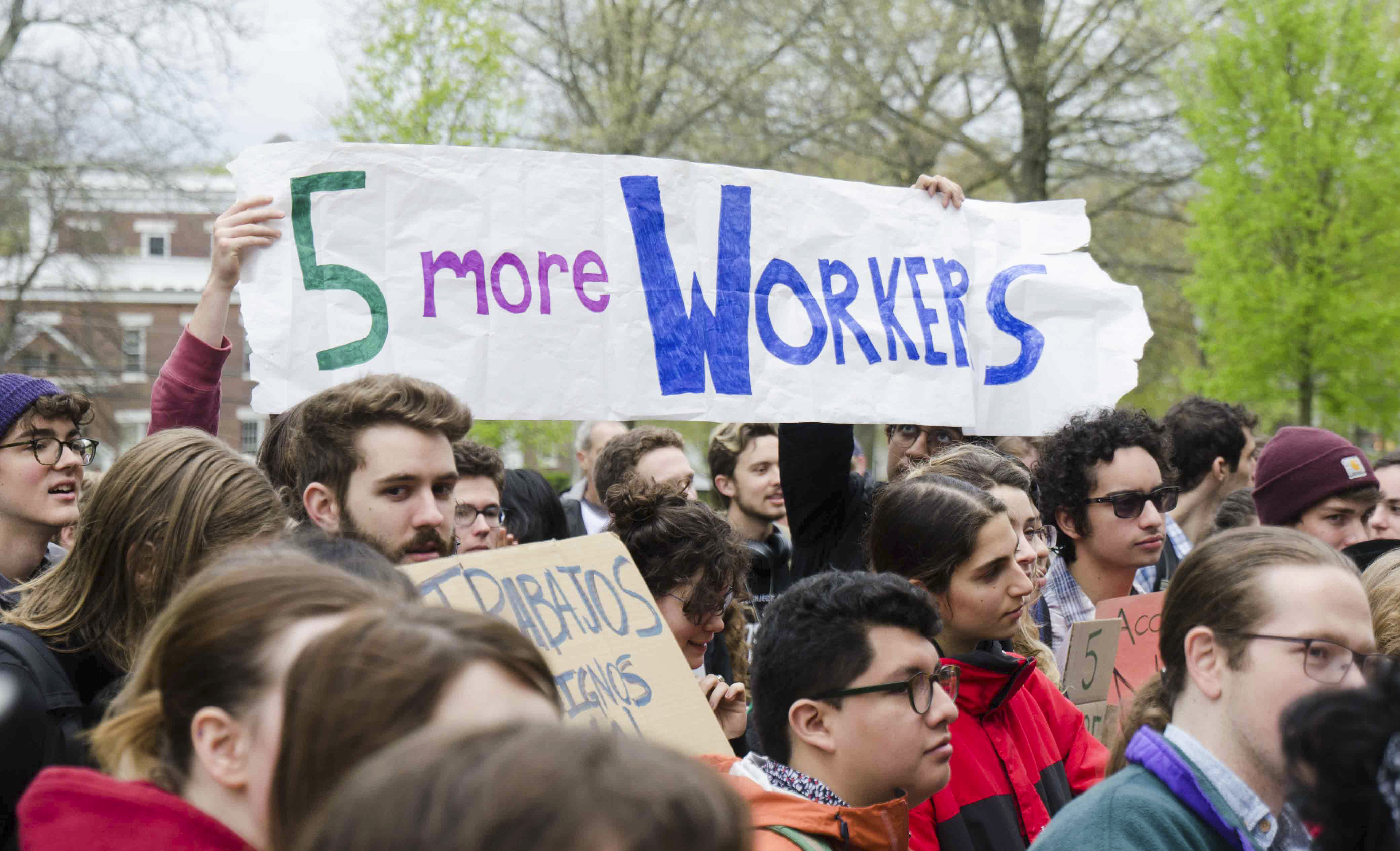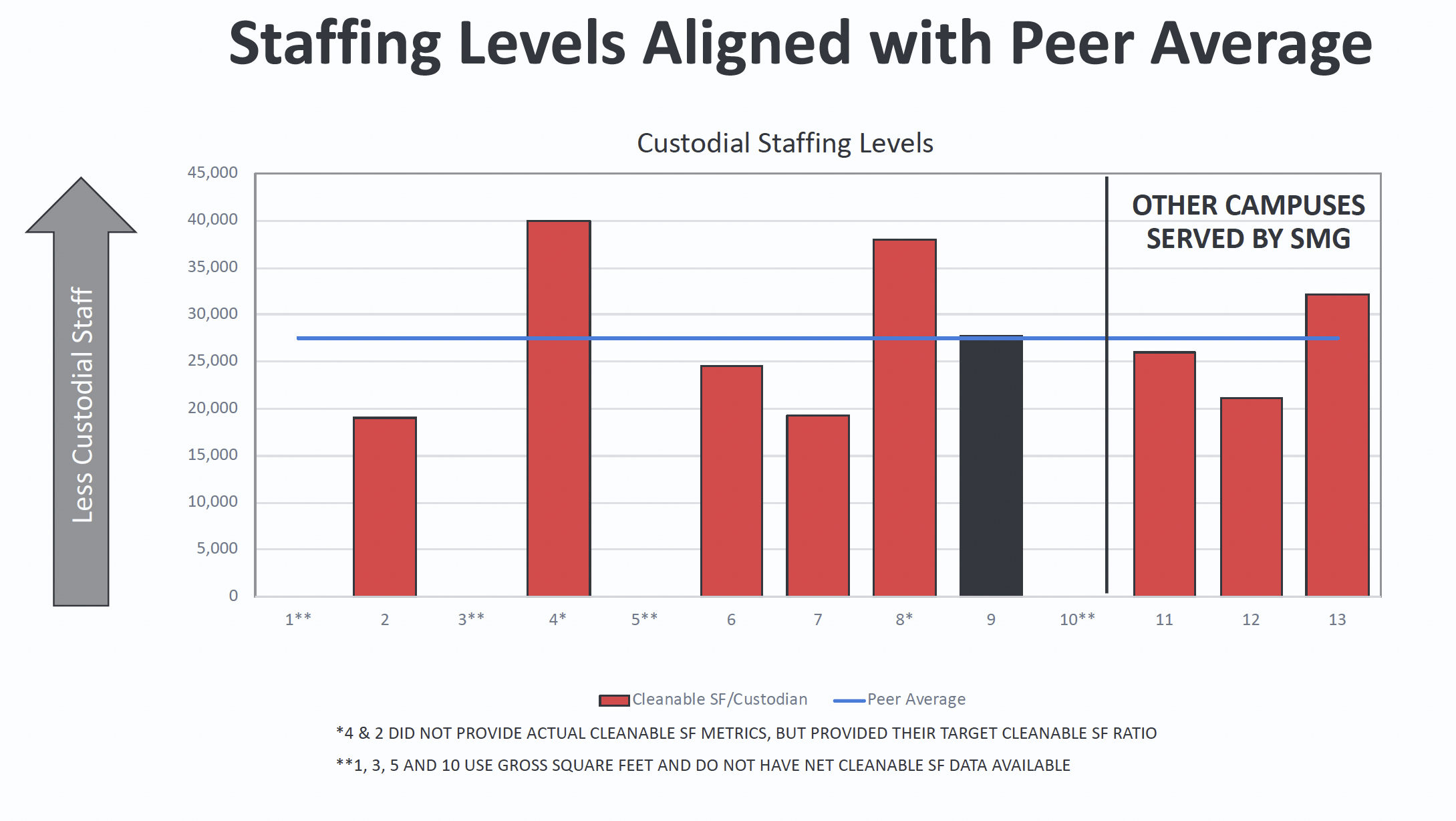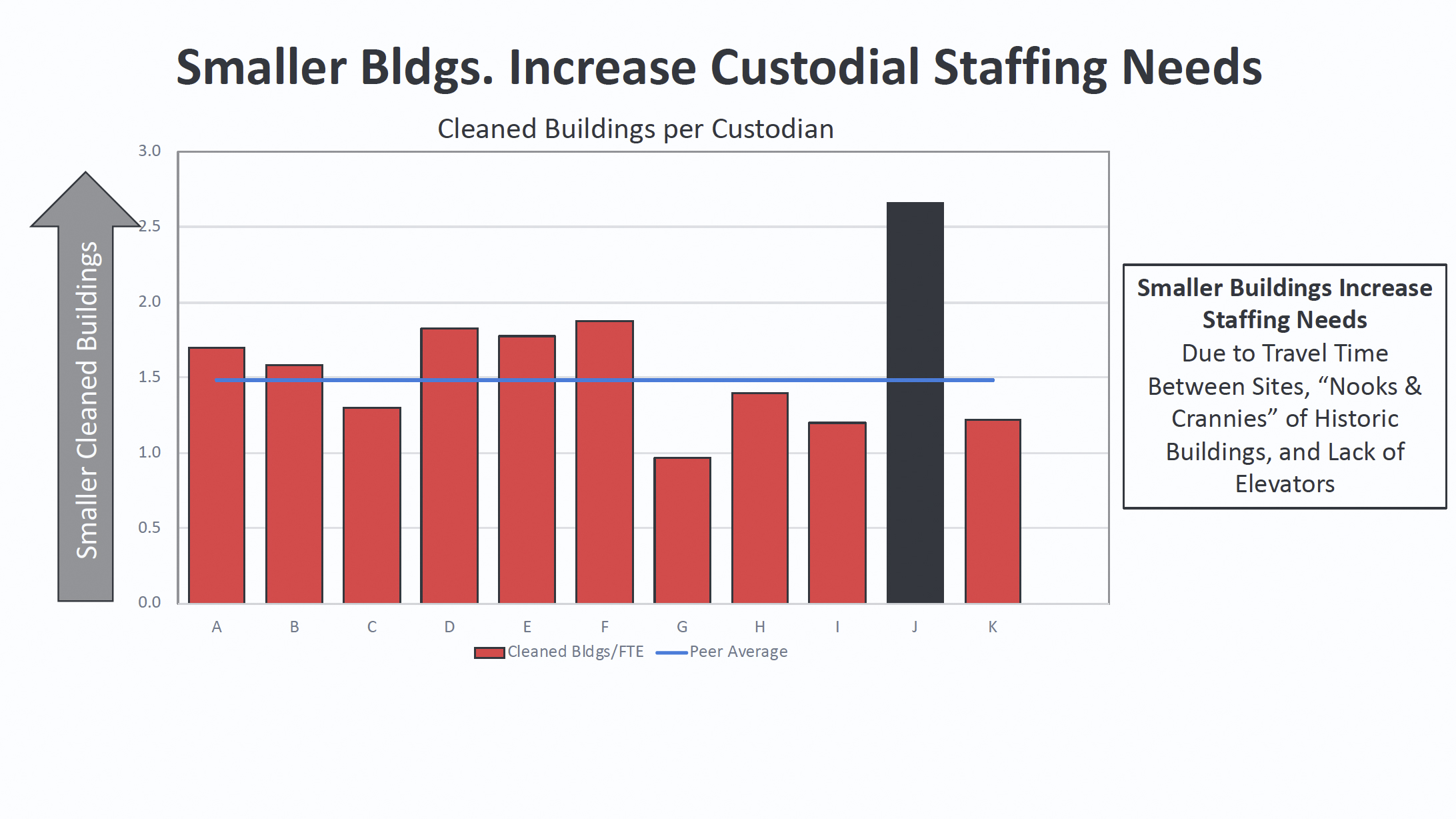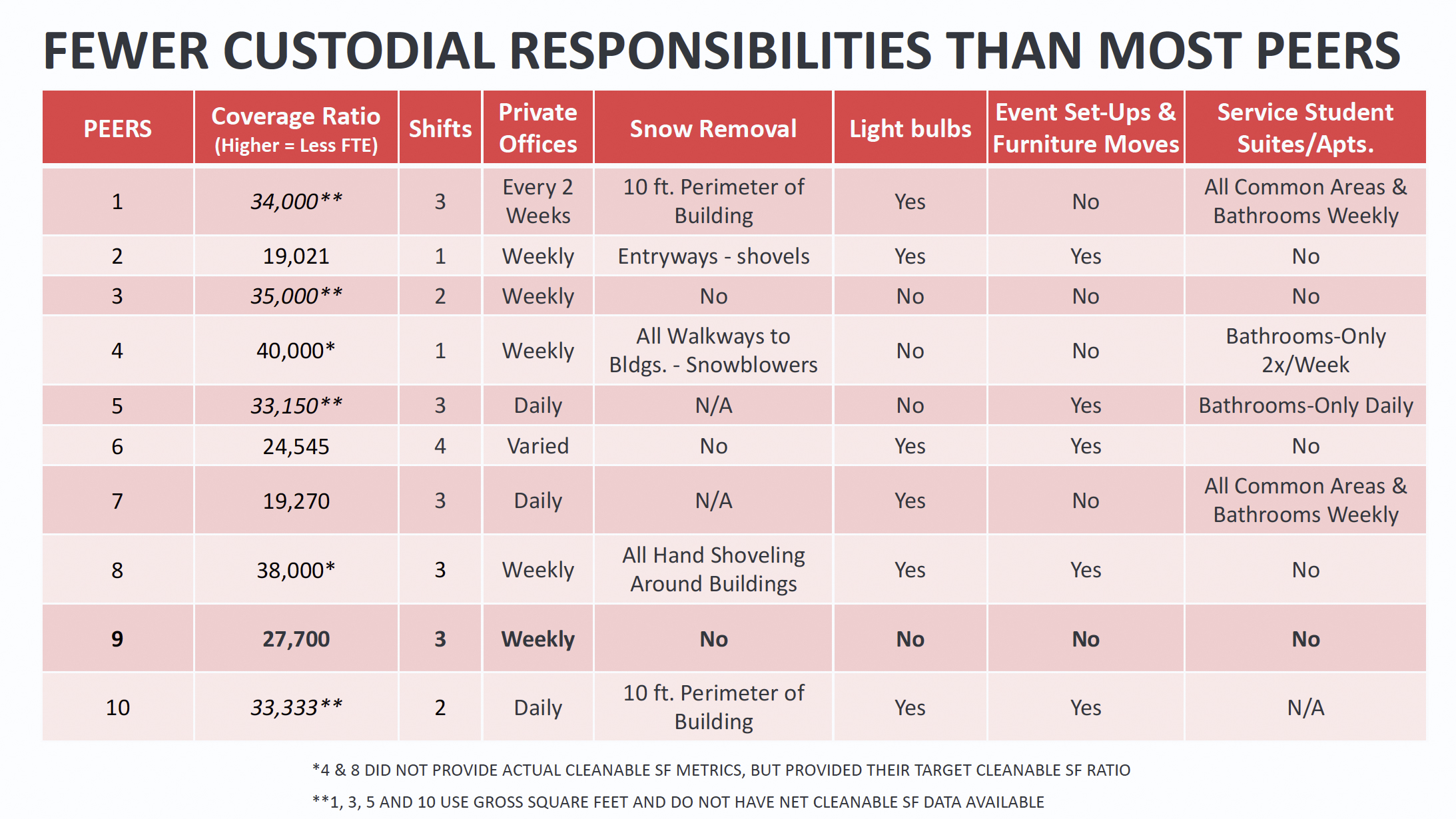
Dani Smotrich-Barr, Photo Editor
Beginning in October and accelerating with protests over WesFest, representatives of the United Student/Labor Action Coalition (USLAC) have demanded that the University hire five more custodians. These demands come in response to unreleased testimony from janitorial staff, collected by USLAC members, that allege unreasonably high workloads for the University’s custodians. USLAC alleges that, after the University subcontracted their janitorial labor in 2012 to SMG Corporate Services (SMG), the decrease in number of custodians on campus from 60 to 50 has saddled custodians with unmanageable workloads.
University administrators are taking an individualized approach to these general complaints but have stated that they cannot act on the anonymous testimony students have provided in meetings and demonstrations.
In an email to The Argus, Interim Chief Communications Officer Deb Katz provided a document from the University titled “Next Steps and Background on Custodian Work.” The document explains that the anonymous nature of these reports prevents the University from addressing specific concerns.
“The students have not provided actionable information, and the anonymous reports students have published are not the basis for addressing any specific claim,” University representatives wrote.
The response maintained that, in order to act upon these concerns, SMG, the workers’ union (SEIU Local 32BJ), or the workers themselves must come forward with an official complaint. The University has yet to receive such a complaint.
“We’re unaware of any official complaints from the SMG workforce to SMG, to their union or to Wesleyan’s administration,” the response continued. “We have talked to SMG supervisors and analyzed daily cleaning assignments—and have not uncovered any new or unresolved issues. If we do encounter issues, SMG will adjust workloads accordingly. Given the information we have available, we have made some improvements, but we see no reason to believe that increasing the number of employees by 10 percent (5 more workers) makes sense at this time.”
The SMG employee handbook, provided by an anonymous source, expressly prohibits workers from discussing their working conditions with the company’s clients, in this case, the University. This stipulation puts workers in a bind: The University will not make changes without named testimony, but SMG could terminate their employment if they go to the University for help.
According to the University response, SMG has plans to place drop boxes at time clock locations for workers to anonymously submit complaints. Workers also have the ability to submit complaints through SMG’s Human Resources (HR) department or their union.
The union contract’s “Workload” section, Article 10, has only one sentence: “No employees shall be assigned an unreasonable workload.” USLAC member Maia Reumann-Moore ’19 believes that unclear terminology surrounding what actually constitutes overwork and SMG’s inconsistent communication has discouraged workers from submitting formal complaints.
“I don’t think there are any current grievances that have to do with overwork with the union, but part of that is the union contract doesn’t really define what overwork is, so I think it would be difficult to file a grievance,” Reumann-Moore said. “But there are people who have complained both through the union and directly to the management of SMG about overwork within the past few years and have either received no response, received a response where they were explicitly told that they should be able to do the workload and shouldn’t complain, or one person was telling us that he was shadowed by [the SMG onsite manager] and [he] promised that he was going to change his workload because he agreed that he was overworked, and then [the manager] never got back to him after that conversation.”
Last October, USLAC petitioned to rehire janitorial worker María Sarabia after she was fired for resting and drinking coffee to raise her blood sugar during her shift. Sarabia attempted to contact her union representative but was met with silence both over the phone and in-person. The union’s reported unresponsiveness could be a factor in why workers have been reluctant to submit formal grievances.
In an effort to gather more information about janitorial workloads, the University asked that SMG have its onsite manager shadow two workers who clean residence halls on Sunday evenings and Monday mornings, shifts which have proven more difficult due to messes accumulated over the weekend.
“As a result of that shadowing and to ensure ample coverage across campus, we recommended to SMG that hours be added on Monday mornings to several housing locations to help with the removal of trash from student parties,” University representatives wrote. “Those changes…have yielded significant improvements.”
Based on the timeline provided by the University, this decision to increase Monday hours occurred in late March before the rallies began. The University response also stated that Physical Plant is currently playing a role to assess and alleviate working conditions.
“Wesleyan Physical Plant is working with students, faculty and staff to identify changes in behavior that might reduce the burden on those who work hard to keep the campus clean,” the response read. The Argus is currently awaiting comment on what these efforts entail. In a meeting with The Argus on April 22, President Michael Roth ’78 explained that the University can act on individual complaints only if they come through formalized and transparent channels.
“Clearly testimonies are of interest, but it’s hard to act on it if it’s anonymous,” Roth said. “It’s not hard; it’s impossible. So I think if there are custodians who feel they’re overworked, then there’s a union and there’s an HR department through which they can show that in the hours they’re working, they’re expected to do too much work.”
Roth went on to assert that he maintains direct lines of communication with janitorial workers.
“I can see it’s not an easy job,” he continued. “I talk to custodians all the time; I don’t think it’s an easy job. So we would like to know how we can be helpful to specific employees of SMG whose workloads are inappropriate. I do think that just adding people—if the workload is wrong, just adding people is not necessarily going to make the workload easier.”
The University’s response centered around the idea that unmanageable workloads can be addressed through personalized action rather than general measures.
“If the person cleaning the science tower has too much work, SMG and the University want to know so we can figure out how to make that workload easier, but the idea that all 50 employees have equally onerous workloads and that they would be alleviated by adding more people, even though they all work the same number of hours as they did before, doesn’t really make a lot of sense,” Roth said.
After initial meetings beginning this fall between USLAC, President Roth, and University administrators, the University, in coordination with SMG, conducted a study of the janitorial workloads of nine other selective liberal arts institutions. The University was not permitted to use the names of the surveyed institutions in the graphs and table that resulted from the study.

c/o Wesleyan University Representatives
The study indicates that the University’s cleanable square footage per full-time equivalent (FTE) is just about average among the surveyed institutions. Several of the included data points provide target square footage per FTE instead of actual cleanable square footage, which, if each institution does not meet its target, could potentially inflate the peer average. The chart also contains an inconsistency (presumably a typo) in which institution “4” and institution “2” are listed as providing target ratios, while the key indicates that “4” and “8” provide the target metrics. Disregarding “4” and “8” would put the University’s ratio of square footage per FTE above the peer average.
“We have no reason to believe their actual staffing level is meaningfully different than that,” Facilities Business Manager Jeff Murphy wrote in an email to The Argus, in response to questions about differences between the target and actual metrics of these institutions.
Another graph shows that the ratio of smaller cleaned buildings to FTE is nearly twice the peer average, with smaller buildings listed as more labor-intensive due to “travel time between sites, ‘nooks and crannies’ of historical buildings, and lack of elevators.” The University has not yet addressed the implications of this data.

c/o Wesleyan University Representatives
USLAC commented on the University’s study in its response to an all-campus email sent by Senior Vice President and Chief Administrative Officer and Treasurer Andy Tanaka ’00 on April 24. In this message, titled “Custodian FAQ,” Tanaka answered questions that have been raised by student activists. USLAC’s response, which the group published in the Facebook event for a rally it held outside North College on Friday, April 26, argues that the University’s inclusion of these target metrics intentionally skews the peer average.
“By including [target numbers] in the data sample, Wesleyan artificially inflated the average workload for custodians to make our custodians’ area size seem normal,” the document reads. “When these two data points are removed, Wesleyan’s custodians are shown to have a larger workload than all of our peer institutions.”
Tanaka’s email also noted that, while the University’s study did not indicate the need to hire five more custodians, the shadowing performed by SMG’s onsite manager did reveal the need for increased hours on Monday mornings.
USLAC’s response addressed the University’s decision to add these hours.
“Though the additional Monday morning hours have been helpful, no amount of overtime can make up for the loss of ten full time employees,” USLAC’s response stated. USLAC’s argument centered around the fact that the increase in student population by 200 has significantly added to the janitorial workload. Tanaka’s email stated that the University did not find the change in student population to be significant.

c/o Wesleyan University Representatives
The results of the study also features a side-by-side comparison of the responsibilities of janitorial workers in relation to the surveyed peer institutions, noting that University custodians do not shovel snow, change lightbulbs, set up events, or clean private bathrooms. Tanaka explained that the original staff size of 60 workers was based on an incorrect estimate of cleanable square footage. After calculating the actual cleanable square footage and presenting the new data to contractors, all of the potential contractors proposed decreased staff sizes from 60 workers.
“Previously the cleanable square footage on campus was based on an estimate, which overstated it by more than 25 percent,” the email explained. “Each potential janitorial contractor submitted a staffing proposal based on the corrected cleanable SF; none of these contractors proposed more than 50 custodians.”
Tanaka’s email pointed out that the University’s decision to reduce the janitorial staff in 2012 occurred alongside a reduction in frequency of private office cleanings, from daily cleanings to weekly cleanings.
“Faculty and staff volunteered to reduce cleaning in office spaces (representing 10 percent of cleanable square feet on campus) from five days per week to one day per week,” the email stated. “Most are voluntarily carrying their own trash and recycling to containers in centralized locations as well. In addition, students agreed to reduce the frequency of cleaning in program houses from five days per week to two to three days per week.”
The University confirmed these reports in their response to The Argus.
“As part of [the 2012] assessment, Wesleyan also reduced the custodian workload by reducing the frequency with which many offices are cleaned,” the response wrote. “Given the amount of space to be cleaned, SMG then posted 50 new positions per union requirements.”
USLAC members Emma Llano ’19 and Reumann-Moore do not see the decreased frequency of cleanings as a viable trade-off for the reduction in staffing.
“It’s kind of ridiculous to [decrease frequency] because the frequency of cleaning doesn’t really make the workload lighter,” USLAC member Llano said. “All of the dirt from that week piles up, so it’s not going to necessarily help their job.”
“The same thing with dorms: Obviously foot traffic, dirt really builds in carpets, grime builds up in bathrooms,” Reumann-Moore explained.
Despite the University’s arguments against USLAC’s demands, which have relied on the above data and the fact that no formal complaints have been issued, USLAC has stuck to its emphasis on personal testimony. At Friday’s rally, USLAC members, custodians, Physical Plant employees, union representatives, and area activists spoke about this perceived inaction by the University.
In a speech she delivered at the rally on Friday, Llano asserted that the results of the administration’s study do not change her position.
“I just want to make one thing very clear: There is no amount of data that can be more valuable to me and to all of us than the story of a worker,” Llano said. “We believe workers, and no amount of numbers or graphs or investigations will change that. Now I’ve seen the data, and it’s nothing but a calculation of how much labor you can possibly get out of one person in eight hours…. It’s simply a cost-cutting tool.”
One custodian, a woman who cleans Bennet and Fauver and whom Llano introduced as Guillermina, expressed her support for USLAC’s demands.
“Trabajo en Bennet y Fauver, perdóname que no sé pronunciarlos bien, pero quiero darles las gracias a los estudiantes para ayudarnos,” Guillermina said in her speech on Friday. “Gracias a Physical Plant por estar aquí con nosotros, apoyándonos. La compañía SMG es muy injusta; todos los compañeros estamos sobrecargado de trabajo y necesitamos ser personas más para tener todo del campo limpio.”
“I work in Bennet and Fauver, excuse me for not knowing how to pronounce those well, but I want to thank all of the students for helping us, and say thank you to Physical Plant for being here with us, supporting us,” a translation of Guillermina’s speech reads. “SMG is a very unjust company; all of us workers are overburdened and we need more people to keep all of campus clean.”
In an April 25 email to The Argus, Murphy affirmed the University’s commitment to responding to individual, formal complaints about working conditions.
“The bottom line is that we are committed to fair and safe conditions for all workers on our campus,” Murphy wrote. “If workers or their union bring to our attention any specific conditions that do not meet these standards, we will take action to ensure that SMG addresses them promptly.”
According to Murphy, custodians met last Wednesday, April 24, with SMG’s HR director to voice their grievances. They raised “a few modest issues” which Murphy wrote will be addressed immediately.
At publication, SMG’s HR director could not be reached for comment.
Correction: A previous version of this article misattributed quotes from a University statement to Facilities Business Manager Jeff Murphy and Associate Director of Facilities Management Jeff Sweet. USLAC efforts to hire five more workers began in October, not during WesFest, but were more heavily publicized at that time. The updated version also includes other edits for clarity, and to attribute reporting to Jordan Saliby.
Jordan Saliby contributed reporting to this article.
William Halliday can be reached at whalliday@wesleyan.edu.
Brooke Kushwaha can be reached at bkushwaha@wesleyan.edu.
Comments are closed